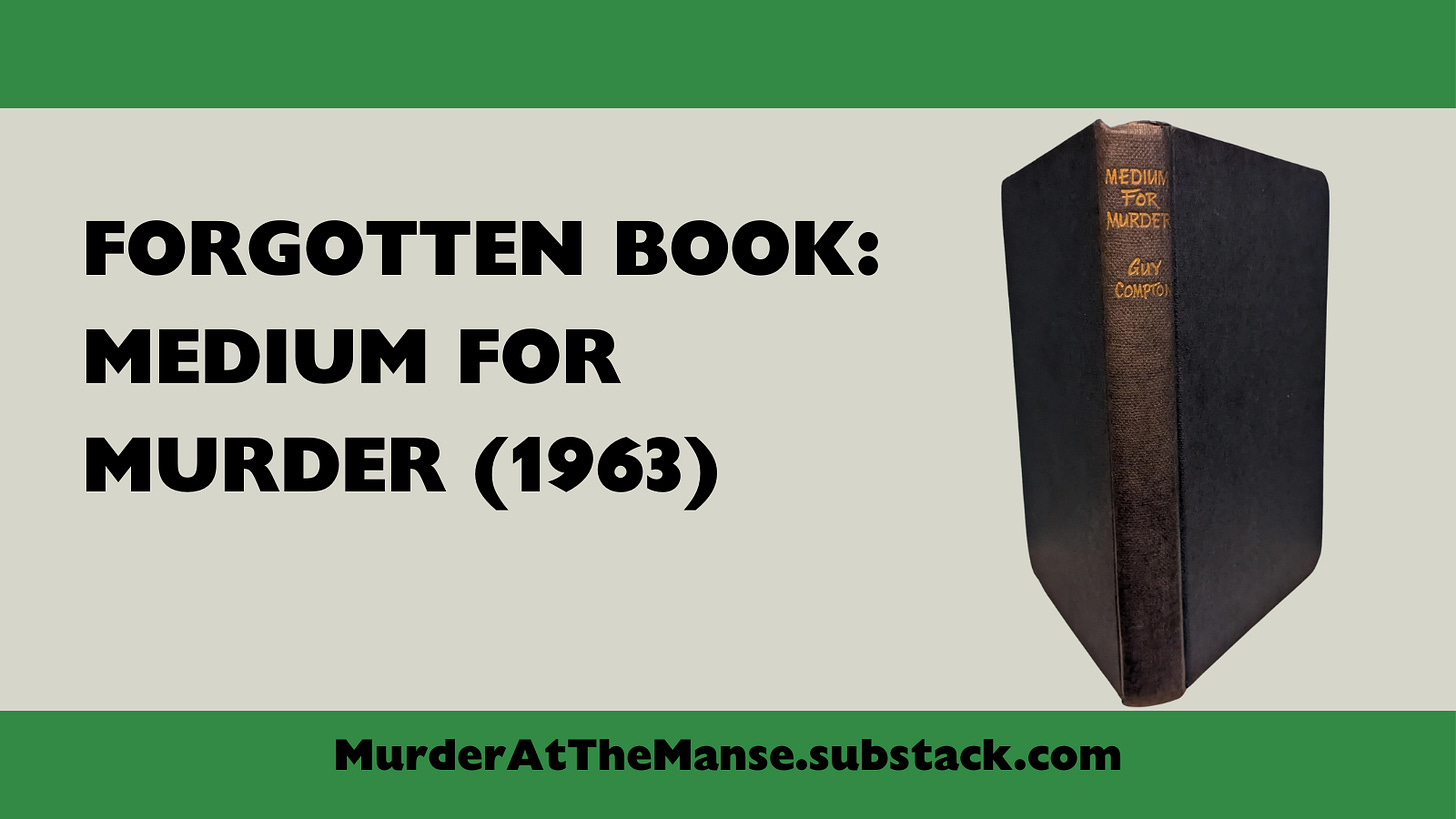This is the first in a new occasional series, where I’ll review some of the lesser-known books from my TBR shelves, following the lead of other bloggers who write about “forgotten” books on Fridays.1 Are these novels overlooked gems or have they been forgotten for a reason? Join me to find out…
For the first book in this series, I’ll be reviewing a book that had a sum total of zero ratings on Goodreads until I added mine. Guy Compton’s Medium for Murder was an impulse buy from Oxfam Books & Music in Tavistock, one of our favourite towns for second-hand bookshopping. I was drawn to the unjacketed blue hardback by the plot synopsis, which promised a mystery set in my home county of Devon. I’m pleased I picked it up, because it proved to be an enjoyable read.
Who was Guy Compton?
Born in London in 1930 as David Guy Compton, he became an award-winning author of near-future science fiction under his initials D. G. Compton. For his sci-fi writing, he was honoured as an Author Emeritus by the Science Fiction and Fantasy Writers of America in 2007, the only British writer to receive this accolade.
Before he ventured into science fiction, though, he produced four murder mysteries as Guy Compton, beginning with Too Many Murderers in 1962. In 1963, Medium for Murder introduced detective-writer Ben Anderson, who also appeared in the 1964 sequel Disguise for a Dead Gentleman. Compton also published Dead on Cue in 1964, before making his science fiction debut in 1965 with The Quality of Mercy. He wrote two further mysteries, High Tide for Hanging (1965) and And Murder Came Too (1966), but then devoted himself to sci-fi.
What’s the book about?
First published by John Long in 1963, Medium for Murder is dedicated to his wife Elizabeth, whom he divorced four years later.2 The prefatory synopsis reads:
When Ben Anderson first came to stay at Buckleigh Coombe in North Devon he found many obstacles placed in his way. The ruined mansion had been the home of a famous—or infamous—medium until he had died there in sensational circumstances after a fall from the Mad Tower.
What started for Ben Anderson as a search for material for his next book soon developed into a game of hide-and-seek with a peculiarly ingenious murderer. The climax is a nightmare car chase along pitch-dark country lanes in the company of a man whom Ben has little or no reason to trust.
The book is part whodunnit, part thriller, as Ben Anderson simultaneously seeks to unravel the truth about the infamous medium’s death, and avoid the threat of impending harm at the hands of an unknown murderer.
How good is it?

I ended up really enjoying Medium for Murder. The writing, setting, characters and plot all added up to a satisfying read.
The setting is an isolated house, Buckleigh Coombe, near the fictional north Devon settlement of Buckleigh Ferrers. This is a stereotypically creepy setting — a decaying property with a “Mad Tower” and “scuttling hordes of assorted vermin”, only partially liveable and occupied by Jane Fuller, sister of the deceased medium Harry. As research for his next book, Ben Anderson rents some rooms to stay in, and finds a number of oddities, including mysterious locked doors and bells that ring of their own accord. And it’s not great when it rains:
Outside the evening darkened, the varying shades of grey merging gradually into a wet black. The rain gathered in the blocked gutters and overflowed onwards down the walls of the rooms beneath… Window-frames sopped it up and swelled, dislodging still further the mortar that was supposed to hold them in place. Sashcords sagged and broke. The whole house shuffled a little nearer to its final collapse and destruction.
From early on, we’re led to be suspicious of Jane Fuller. But several other characters are suspicious too, including a disappearing cousin, and we’re left wondering who we can trust. Our fate is in the hands of an inquisitive protagonist, Ben Anderson, who writes under the pseudonym Bennet Anders. Guy Compton makes good use of the author connection, with some fun moments where Ben reflects on the mystery as if it’s a novel. Towards the end, he mentally itemises unlikely suspects: “The sort of people lesser whodunnit writers dragged in at the last minute.”
The plot opens with a prologue that recounts the night-time death of a tramp, Pram Watkins. The narrative then jumps ahead four months, when we learn about another death — though we have to wait a while to find out the significance of Pram Watkins. Throughout the narrative, Guy Compton highlights other key events or clues whose significance is undetermined. He then itemises these on page 130 (out of 184), where the protagonist provides the reader with a list of 10 “Incomprehensibles” — puzzling facts, details and inconsistencies, which prove to be key to the mystery’s resolution. Some of the plot is predictable, but there are some puzzling elements and surprises in store too.
Overall, this was definitely an enjoyable read, and I would put it in the category of “unjustly neglected”. Hopefully, I’ll find another Guy Compton volume on our next trip to Tavistock…
Verdict: ⭐⭐⭐⭐ (4/5)
Including Aubrey Hamilton at Happiness is a Book, Martin Edwards at his blog, BV Lawson at In Reference to Murder, and the blog A Hot Cup of Pleasure.
My unjacketed hardback was the 1964 edition published by The Mystery Book Guild, and printed by The Anchor Press, Tiptree, on Antique Wove paper.






